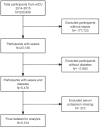Linear association between serum potassium levels and 28-day mortality among ICU patients with diabetes and sepsis: a multicenter study
- PMID: 40520788
- PMCID: PMC12162910
- DOI: 10.3389/fmed.2025.1582894
Linear association between serum potassium levels and 28-day mortality among ICU patients with diabetes and sepsis: a multicenter study
Abstract
Background: Dysregulation of serum potassium is a common electrolyte disturbance in critically ill patients, and both hypokalemia and hyperkalemia have been linked to adverse outcomes in sepsis. However, the relationship between serum potassium levels and mortality in ICU patients with diabetes and sepsis remains poorly understood.
Methods: A retrospective cohort study was conducted using data from the eICU Collaborative Research Database (2014-2015). The study included 5,104 adult ICU patients with diabetes and sepsis from 208 hospitals in the U.S. Serum potassium levels measured within 24 h of ICU admission were categorized into hypokalemia (<3.5 mmol/L), normokalemia (3.5-5.0 mmol/L), and hyperkalemia (>5.0 mmol/L). Multivariable logistic regression models were used to assess the association between serum potassium levels and 28-day ICU mortality.
Results: Of the 5,104 patients (mean age, 66.8 years; 49.1% male), 1,046 (20.5%) had hypokalemia, 3,377 (66.2%) had normokalemia, and 681 (13.3%) had hyperkalemia. After adjusting for demographic factors, comorbidities, and treatment measures, each 1 mmol/L increase in serum potassium was associated with a 25% higher risk of 28-day mortality (adjusted OR, 1.25; 95% CI, 1.07-1.47). Compared to hypokalemia, hyperkalemia was associated with significantly higher mortality risk (adjusted OR, 1.86; 95% CI, 1.17-2.96). A linear relationship was observed between serum potassium levels and mortality (P = 0.006), differing from the previously reported U-shaped relationship in general ICU populations.
Conclusions and relevance: Elevated serum potassium levels were independently associated with increased 28-day mortality in ICU patients with diabetes and sepsis. These findings suggest that potassium management strategies should be specifically tailored for this high-risk patient population.
Keywords: ICU; diabetes; hyperkalemia; hypokalemia; mortality; sepsis; serum potassium.
Copyright © 2025 Cai, Zhang, Gao, Chen, Li, Lin, Mou, Ni and Jin.
Conflict of interest statement
XC was employed by X&Y Solutions Inc. The remaining authors declare that the research was conducted in the absence of any commercial or financial relationships that could be construed as a potential conflict of interest.
Figures


Similar articles
-
Influence of dyskalemia at admission and early dyskalemia correction on survival and cardiac events of critically ill patients.Crit Care. 2019 Dec 19;23(1):415. doi: 10.1186/s13054-019-2679-z. Crit Care. 2019. PMID: 31856891 Free PMC article.
-
Association between admission baseline blood potassium levels and all-cause mortality in patients with acute kidney injury combined with sepsis: A retrospective cohort study.PLoS One. 2024 Nov 20;19(11):e0309764. doi: 10.1371/journal.pone.0309764. eCollection 2024. PLoS One. 2024. PMID: 39565797 Free PMC article.
-
[Association between serum potassium levels and all-cause mortality in patients with acute heart failure].Zhonghua Yi Xue Za Zhi. 2023 Mar 14;103(10):727-732. doi: 10.3760/cma.j.cn112137-20220707-01504. Zhonghua Yi Xue Za Zhi. 2023. PMID: 36889685 Chinese.
-
Admission serum sodium and potassium levels predict survival among critically ill patients with acute kidney injury: a cohort study.BMC Nephrol. 2019 Aug 8;20(1):311. doi: 10.1186/s12882-019-1505-9. BMC Nephrol. 2019. PMID: 31395027 Free PMC article.
-
Serum potassium and heart failure: association, causation, and clinical implications.Heart Fail Rev. 2021 May;26(3):479-486. doi: 10.1007/s10741-020-10039-9. Epub 2020 Oct 23. Heart Fail Rev. 2021. PMID: 33098029 Review.
References
LinkOut - more resources
Full Text Sources

